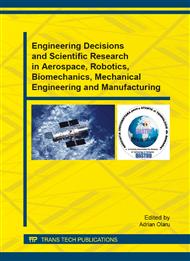[1]
F. Moreno-Hines, Real Options Applications for Public Sector Investment and Acquisitions, MITRE Technology Program, (2007), On line at: http: /www. mitre. org/news/events/ tech07/1. html.
Google Scholar
[2]
J. Mun, Real Options Analysis: tools and techniques for valuing strategic investments and decisions, John Wiley and Sons, New Jersey, 2002, pp.77-92.
DOI: 10.1002/9781119201618
Google Scholar
[3]
R.P. Rumelt, D.E. Schendel, D.J. Teece, (1994), Fundamental Issues in Strategy: A Research Agenda, Boston, MA: Harvard Business School Press, 1994, pp.9-47.
Google Scholar
[4]
L. Trigeorgis, Real Options: Managerial Flexibility and Strategy in Resource Allocation, Cambridge, MA: MIT Press, (1996).
Google Scholar
[5]
T. Chi, D.J. McGuire, Collaborative Ventures and Value of Learning: Integrating the Transaction Cost and Strategic Option Perspectives on the Choice of Market Entry Modes, Journal of International Business Studies 27(2) (1996) 285-307.
DOI: 10.1057/palgrave.jibs.8490136
Google Scholar
[6]
A. Arya, J. Glover, B.R. Routledge, Project Assignment Rights and Incentives for Eliciting Ideas. Management Science 48(7) (2002) 886-899.
DOI: 10.1287/mnsc.48.7.886.2822
Google Scholar
[7]
B. Kogut, N. Kulatilaka, Capabilities as real options, Organization Science 12(6) (2001) 744-758.
DOI: 10.1287/orsc.12.6.744.10082
Google Scholar
[8]
T.B. Folta, K.D. Miller, Real Options in Equity Partnerships, Strategic Management Journal 23(1) (2002) 77-88.
DOI: 10.1002/smj.209
Google Scholar
[9]
H.T.J. Smit, L.G. Trigeorgis, Strategic Investment: Real Options and Games, Princeton, NJ: Princeton University Press, (2004).
Google Scholar
[10]
T. Copeland, V. Antikarov, Real Options – A Practitioners Guide, Texere Publishing, (2001).
Google Scholar
[11]
T.A. Luerhman, Capital Projects as Real Options: An Introduction, Harvard Business School Cases, [online], Boston: Harvard Business School, (1996).
Google Scholar
[12]
G. Heal, H. Kunreuther, Interdependent Security: A General Model, National Bureau of Economic Research, Working Paper 10706, (2004), available on: http: /www. nber. org/ papers/w10706, [Accessed 12 March 2013].
Google Scholar
[13]
S. -S. Chen, R. K. Chou, S. -F. Chou, The Impact of Investment Opportunities and Free Cash Flow on Financial Liberalization: A Cross-Firm Analysis of Emerging Economies, Financial Management, Volume 38(3) (2009) 543–566.
DOI: 10.1111/j.1755-053x.2009.01047.x
Google Scholar
[14]
L. -C. Wu, C. -S. Ong, Y. -W. Hsu, Active ERP implementation management: A Real Options perspective, The Journal of Systems and Software 81 (2008) 1039–1050.
DOI: 10.1016/j.jss.2007.10.004
Google Scholar
[15]
C. Carlsson, R. Fuller, A fuzzy approach to real option valuation, Fuzzy Sets and Systems 139 (2003) 297–312.
DOI: 10.1016/s0165-0114(02)00591-2
Google Scholar
[16]
A. Rose, Analyzing Terrorist Threats to the Economy: A Computable General Equilibrium Approach, Published Articles & Papers, Paper 77, (2005), available on: http: /research. create. usc. edu/published_papers/77, [Accessed 22 April 2013].
DOI: 10.4337/9781845428150.00016
Google Scholar
[17]
A. Rose, S.B. Blomberg, The Economic Impacts of the September 11, 2001, Terrorist Attacks, Peace Economics, Peace Science and Public Policy, vol. 15(2) (2009).
DOI: 10.2202/1554-8597.1165
Google Scholar
[18]
J.R. Santos, Y.Y. Haimes, Modeling the Demand Reduction Input-Output (I-O) Inoperability Due to Terrorism of Interconnected Infrastructures, Risk Analysis 24: 6 (2004) 1437-1451.
DOI: 10.1111/j.0272-4332.2004.00540.x
Google Scholar
[19]
T. Balvanyos, B.L. Lester, The Economic Implications of Terrorist Attack on Commercial Aviation in the USA, report to the Center for Risk and Economic Analysis of Terrorism (CREATE), University of Southern California, Los Angeles, (2005).
Google Scholar
[20]
P. Gordon, H. Richardson, J. Moore, J. Park, S. Kim, Economic Impacts of a Terrorist Attack on the U.S. Commercial Aviation System, Risk Analysis 27(3) (2007) 505-12.
DOI: 10.1111/j.1539-6924.2007.00903.x
Google Scholar
[21]
U.S. Department of Homeland Security, Fact Sheet: Countering Missle Threats to Commercial Aircraft, Press Release, Distributed by Bureau of International Information Programs, U.S. Department of State, (2004).
Google Scholar
[22]
C. Bolkom, B. Elias, Homeland Security: Protecting Airliners from Terrorist Missiles. Washington, DC: Congressional Research Service, Library of Congress, (2006).
Google Scholar
[23]
C. Cioacă, C.G. Constantinescu, M. Boșcoianu, Extreme Risk Assessment Methodology (Eram) In Aviation System, Environmental Engineering and Management Journal, (2013), [under review].
Google Scholar


